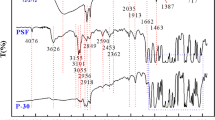Abstract
The pore conformation of polymeric membranes can be significantly altered upon interaction of the membranes with organic solvents affecting the performances of the membranes. Polymer shows swelling properties to organic solvents. Here, we show that swelling properties of polysulfone ultrafiltration membrane can be significantly altered by hexane treatment resulting in a change in the pure water permeability, macromolecule separation, and porosity. The water permeability of the membranes decreased with the dipping time in hexane. It showed that the rate of decrement in water permeability was about ten times for PS-24 (prepared from 24 %, w/w solution in DMF) compared to PS-15 (prepared from 15 %, w/w solution in DMF) while the % solute (macromolecule) rejection was decreased by about 11–17 % for the membranes. The SEM and AFM techniques also revealed the porosity changes as evident from surface microstructure morphology. Our results represent a method for tuning membrane properties without the synthetic efforts.









Similar content being viewed by others
References
Cheryan M (1998) Ultrafiltration and microfiltration handbook. Technomic, Lancaster
Rafe A, Razavi MSA (2009) Water and hexane permeate flux through UF polysulfone amide membrane. Desalination 236:39–45
Lin L, Rhee KC, Koseoglu SS (1997) Bench-scale membrane degumming of crude vegetable oil: process optimization. J Membr Sci 134:101–108
Koseoglu SS, Engelgau DE (1990) Membrane applications and research in the edible oil industry: an assessment. J Am Oil Chem Soc 67:239–249
Kale V, Kankanenu SPR, Cheryan M (1999) Deacidifying rice bran oil by solvent extraction and membrane technology. J Am Oil Chem Soc 76:723–727
Raman LP, Cheryan M, Rajagopalan N (1996) Deacidification of soybean oil by membrane technology. J Am Oil Chem Soc 73:219–224
Nguyen QT, Aptel P, Neel J (1979) Characterization of ultrafiltration membranes. Part I. Water and organic-solvent permeabilities. J Membr Sci 5:235–251
Mukherjee D, Kulkarni A, Gill WN (1996) Chemical treatment for improved performance of reverse osmosis membranes. Desalination 104:239–249
Cai B-X (2004) Permselectivity of polyamide composite membrane modified by solvent. J Appl Polym Sci 92:1005–1010
Agrawal VK, Singh PS (2012) Alcohol-induced change of ‘‘reverse osmosis’’ polyamide membrane surface. J Appl Polym Sci 124(S1):E290–E299
Lencki RW, Williams S (1995) Effect of non-aqueous solvents on the flux behaviour of ultrafiltration membranes. J Membr Sci. 101:43–51
Koseoglu SS, Lawhon JT, Lusas EW (1990) Membrane processing of crude vegetable oils: pilot plant scale removal of solvent from oil miscella. J Am Oil Chem Soc 67:315–322
Raman LP, Cheryan M, Rajagopalan N (1996) Solvent recovery and partial deacidification of vegetable oils by membrane technology. Eur J Lipid Sci Tech 98:10–14
Di Luccio M, Nobrega R, Borges CP (2000) Microporous anisotropic phase inversion membranes from bisphenol-A polycarbonate: study of a ternary system. Polymer 41(11):4309–4315
Acknowledgments
The authors would like to thank Council of Scientific and Industrial research, India for financial support as research Grants (9/1/CS/CSMCRI(1)/2012-13-PPD) under 12th Five-year-plan CSIR Network project. The instrumentation facility provided by ‘Analytical Discipline and Centralized Instrument Facility’, CSIR-CSMCRI, Bhavnagar, is also gratefully acknowledged. CSIR-CSMCRI Communication No. 003.
Author information
Authors and Affiliations
Corresponding authors
Rights and permissions
About this article
Cite this article
Saxena, M., Ray, P., Singh, P.S. et al. Studies towards understanding the effect of hexane on polysulfone membranes. Polym. Bull. 72, 2157–2169 (2015). https://doi.org/10.1007/s00289-015-1395-3
Received:
Revised:
Accepted:
Published:
Issue Date:
DOI: https://doi.org/10.1007/s00289-015-1395-3




